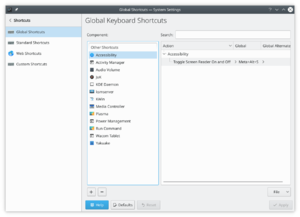System Settings/Shortcuts and Gestures/fr: Difference between revisions
(Created page with "Cette commande vous permet de fermer la prochaine fenêtre que vous cliquerez. {{Note|wmctrl peut ne pas fonctionner pour votre gestionnaire de fenêtres.}}") |
(Created page with "pour fermer la fenêtre active") |
||
| Line 61: | Line 61: | ||
{{Input|1=Command/URL: wmctrl -c :SELECT:}} | {{Input|1=Command/URL: wmctrl -c :SELECT:}} | ||
pour fermer la fenêtre active | |||
{{Input|1=Command/URL: wmctrl -c :ACTIVE:}} | {{Input|1=Command/URL: wmctrl -c :ACTIVE:}} | ||
Revision as of 10:06, 17 May 2012
 |
Edit system wide keyboard shortcuts and mouse gestures |

Custom Shortcuts
Here you edit settings for input actions, including mouse gestures.

Standard Keyboard Shortcuts
Here you can configure the keyboard shortcuts for a number of actions common to many applications. This includes actions such as Open, Save, Close, Cut, Copy, Paste, Find, and many more.

Global Keyboard Shortcuts
Global keyboard shortcuts are used to interface with applications that do not display an interface. Settings for such shortcuts are edited here.
Gestes de la souris
The place where you start is (in KDE SC 4.5 it is )
Activer les gestes de souris
Dans le coin inférieur gauche de la fenêtre il y a un bouton . Assurez-vous que la case soit cochée. Réglez le temps de pause comme bon vous semble. Le bouton de la souris peut être différent pour vous, j'ai choisi 3 pour utiliser le bouton droit de la souris. Si vous voulez que les actions d'entrée soient activées automatiquement, cochez « Démarrer le démon Actions d'entrée au démarrage ».
Créer le groupe d'actions de gestes de souris
Faites un clic droit sur le panneau de gauche (dans une zone vide sous la liste des groupes) et choisissez , renommez ce groupe en « gestes de souris » et cochez la case attaché à son nom.
Créer un nouveau geste de souris
À partir de maintenant, je vais supposer que le nouveau groupe s'appelle « Gestes de souris ». Faites un clic droit sur et choisissez (Ici il y a trois options, mais je n'ai pas réussi à travailler sur « Envoyez l'entrée du clavier ») en utilisant « Commande/URL » ou « Commande D-Bus », vous devrez créer un geste et le lier à une action.
Pour créer le geste
Cliquez sur votre et sélectionnez l'onglet . Dans le bas de l'écran il y a un bouton (cliquez dessus). Dans la zone qui vient de s'ouvrir, dessinez votre geste en utilisant le bouton gauche de la souris.
Pour lier une action
si vous avez choisi il suffit d'entrer cette commande/url sous l'onglet dans le champ .
Exemples utilisant une commande/URL
Fermer une fenêtre
Cette commande vous permet de fermer la prochaine fenêtre que vous cliquerez.
Command/URL: wmctrl -c :SELECT:
pour fermer la fenêtre active
Command/URL: wmctrl -c :ACTIVE:
Translate clipboard content
This command will display a translation of the current clipboard content.
- Required for this are:
- xclip
- libtranslate
Command/URL: kdialog --title "Translation" --msgbox "`xclip -o | translate -f en -t he -`"
Replace 'en' and 'he' with the desired source and destination language, if you are not sure, a full list of language codes is available from the ISO 639-2 list.
Examples using D-Bus
If you chose D-Bus, here are few examples.
Finding out what to fill where, is done with the help of the "Launch D-Bus Browser", using that browser you can find what method you wish to call in what application object. Using D-Bus we need to fill some fields, the field name will be regular and the content italic.
Runner
This will display the Runner dialog.
Remote Application: org.kde.krunner
Remote Object: /App
Function: org.kde.krunner.App.display
Audacious next/previous/pause/play/stop/repeat track
Remote Application: org.mpris.audacious
Remote Object: /Player
Function: org.freedesktop.MediaPlayer.Next (replace Next with Prev/Pause/Stop/Play/Repeat)
Audacious PlayPause track
If not playing will play, if playing will pause.
Remote Application: org.mpris.audacious
Remote Object: /org/atheme/audacious
Function: org.atheme.audacious.PlayPause
display the actions pop-up. (I am using that to search and translate words)
Remote Application: org.kde.klipper
Remote Object: /klipper
Function: org.kde.klipper.klipper.showKlipperManuallyInvokeActionMenu


